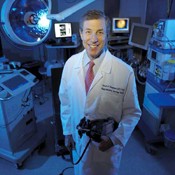
David Abramson is shown surrounded by the state-of-the-art technology he uses to treat children with retinoblastoma.
Less than 100 years ago, a diagnosis of retinoblastoma, a rare cancer affecting the retinas of young children, was a death sentence. It wasn’t until the 1930s that doctors at Memorial Hospital for Cancer and Allied Diseases helped to establish some of the first retinoblastoma treatment successes. Now, more than 70 years later, the evolution of those early advances continues at Memorial Sloan Kettering Cancer Center under the guidance of David H. Abramson, Chief of the Ophthalmic Oncology Service.
Each year in the United States, there are approximately 350 diagnoses of retinoblastoma — the most common eye cancer in children. For 90 percent of retinoblastoma cases, the affected child is the first in the family to have the disease, which, in these instances, is caused by a randomly occurring genetic mutation in chromosome 13. For the remaining ten percent, a mutation in the same gene is inherited (meaning that each child of a parent with retinoblastoma has about a 50 percent chance of inheriting the disease).
In the 1930s, a surgeon at Memorial Hospital named Hayes Martin teamed with an ophthalmologist named Algernon Reese to experiment with new treatment techniques. Enucleation, the surgical removal of the affected eye, was then and remains now the primary treatment option for retinoblastoma, but Dr. Martin and Dr. Reese were able to save some children’s eyes using radiation therapy. “This was a revolutionary concept then,” said Dr. Abramson. “Before this, all of these children would have died.” (With treatment, today more than 95 percent of children survive.)
Dr. Reese moved to Columbia Presbyterian Medical Center, where he trained and was succeeded by a young ophthalmologist named Robert Ellsworth. It was at Columbia, in the mid-1970s, that Dr. Abramson began to work with Dr. Ellsworth. The partnership would last for the next 20 years, during which they moved their eye cancer practice to New York Hospital.
In 2003, Dr. Abramson — who treats all cancers on, in, and around the eye — moved his practice to Memorial Sloan Kettering Cancer Center, completing the circle that was begun some 30 years earlier. “At this point in my career,” Dr. Abramson explained, “I felt that to make the next big advances in our field would require an immersion in the cancer world. I believed that we could take our patients to the next level of treatment success.”
At Memorial Sloan Kettering Cancer Center, Dr. Abramson and his team have helped to advance the use of cutting-edge vision-saving techniques, including radioactive plaques (inserting radioactive discs directly into the affected eye), laser therapy, cryotherapy (freezing smaller tumors), and chemoreduction (shrinking tumors with chemotherapy). Each patient is seen in a state-of-the-art suite of examination and treatment rooms dedicated to retinoblastoma. “There is literally no other space like it in the world,” said Dr. Abramson.
Most recently, working in collaboration with Zev Rosenwaks from Weill Cornell Medical Center, Dr. Abramson and his team used a technique known as preimplantation genetic testing in families at risk for having children with inherited retinoblastoma. After fertilizing 20 embryos from one couple using standard in vitro fertilization techniques, doctors tested each embryo for the mutation. Five of the embryos that were found to be free of the mutation were implanted in the mother’s womb, resulting in the successful birth of a single, retinoblastoma-free child. The team has since repeated this success.
“The last 100 years have been a wonderful story of retinoblastoma treatment evolution,” said Dr. Abramson, referring to the work that began with Drs. Martin and Reese. “But in the next ten years, there will be a revolution. These children will live in an entirely new world of hope.”
